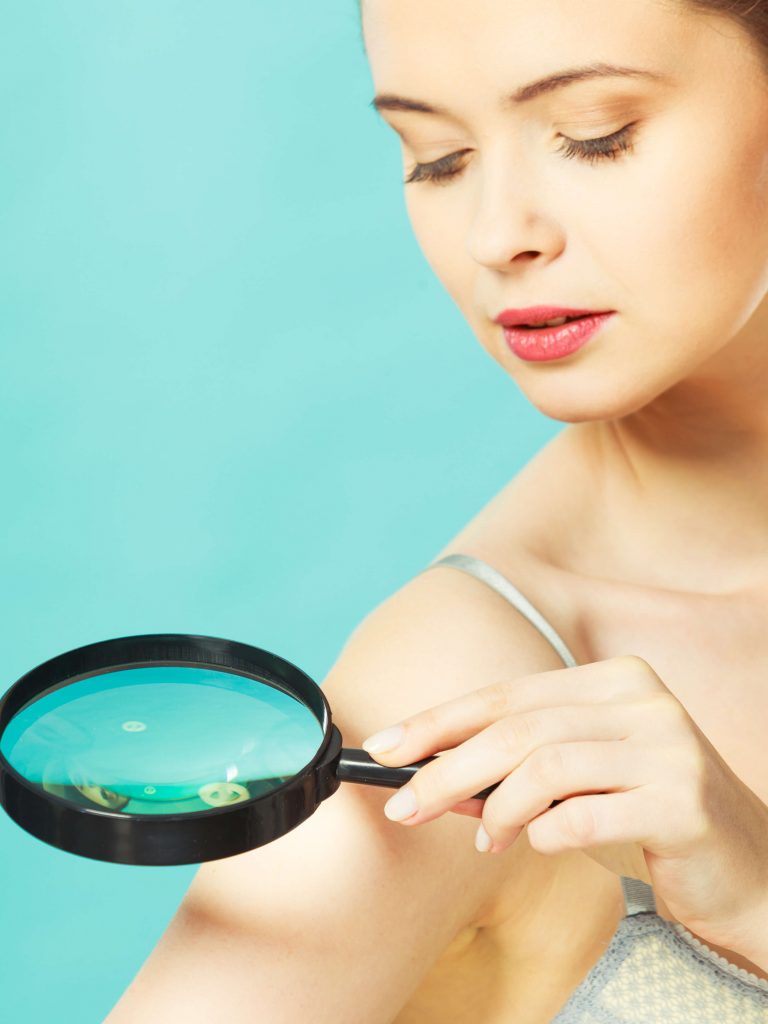How Can I Check Myself for Skin Cancer?
Have you noticed strange moles and unnatural pigmentation appearing on your skin? Are you worried you might have skin cancer caused by exposure to harsh sunlight over a long period of time? In addition to arranging a professional examination to determine whether or not you have skin cancer, it can be useful to conduct an initial self-check.
Mole Check Clinic has compiled this comprehensive blog post with useful information on skin cancer to assist people who are concerned but have yet to get confirmation from a doctor. Continue reading for more details, advice and recommendations on identifying, assessing and treating skin cancer.
What Do the Early Signs of Skin Cancer Look Like?
Identifying the early signs of skin cancer is extremely important. The sooner you detect something unusual on your skin and get yourself checked by a professional, the higher your chances of successful treatment of cancer. Checking your body for these early symptoms is relatively straightforward, but you also need to know what you’re looking for, otherwise you might glance over an irregularity that might be cancerous rather than benign.
Checking your skin on a regular basis will help you get to know it well enough so that you can more easily identify any changes when they occur and arrange professional screening if necessary. Some of the changes that might indicate cancerous growths can include:
- Appearance of new spots
- Change in size or shape of existing spots (especially with irregular edges)
- Change in the spot’s outline
- A loss of symmetry
- Change of colour from brown to black or irregular colour
- Development of a lump, thickening or a raise above the skin surface
- Itchiness, pain, bleeding, crustiness, inflammation
What are the Main Warning Signs of Skin Cancer?
The Cancer Council of Australia has created an ABCDE detection guide to follow during examination. Please remember that these signs don’t always constitute confirmation and that you should always follow it up with an appointment for a skin cancer screening. The ABCDE detection guide suggests that you keep a close eye on the following characteristics:
- Asymmetry – Moles and spots that are asymmetric and have two sides that don’t match up
- Border – Moles and spots whose edges are irregular or spreading
- Colour – Moles and spots that have unusual or changing colours, such as black, red, and blue
- Diameter – Moles and spots that grow larger over time
- Evolving – Moles and spots that are constantly changing in size and colour
How Do You Check Yourself for Skin Cancer?
- Stand fully unclothed in front of a full length mirror in a well lit room.
- Start from the scalp and work your way down your entire body.
- Check your scalp by using a brush or hairdryer to part your hair into sections.
- Move to your face and neck, not forgetting around your mouth, around your eyes, ears, nostrils and lips.
- Be sure to check both the top and underneath of your arms including your forearms, wrists, fingers and under nails..
- Move to your torso and back. Use a mirror or get a family member to check your back.
- As you move down your body check your private parts, buttocks, the back of your legs and lower back. Melanoma can be found in places that do not have exposed skin.
- Sit down to inspect each of your legs thoroughly. Prop them on a chair or stool checking both sides of your legs, thighs, shin, ankles as well as the soles of your feet, between your toes and toe nails.
- The best way to monitor changes on your skin is by taking photographs every few months and comparing them to identify any changes. Contact a skin cancer clinic immediately to get a full body screening if you notice growing or discoloured spots when comparing to previous photographs.
How Can You Identify Skin Cancer?
Skin cancer is a broad term that encompasses multiple sub-types. Knowing the differences between the different types of skin cancer can better equip you to identify abnormalities early and seek further clarification so you can reduce the risk of cancer. The main types of skin cancer include:
- Basal Cell Carcinoma – The most common form of skin cancer and the least dangerous. Grows slowly, manifests as a lump or scaly area, red or pale in colour
- Squamous Cell Carcinoma – More common among people over the age of 50, squamous cell carcinoma grows slowly over several months on sun-exposed areas and manifests as a thickened and ready scaly spot that can bleed, ulcerate and crust
- Melanoma – The most deadly form of skin cancer that can spread to other parts of the body. It may appear in a mole or a dark spot or it could manifest a as new spots that change colour, size or shape
- Nodular Melanoma – Firm and dome-shaped lesions that grow quickly and bleed after a while
Are Skin Cancers Itchy?
Spots and lesions that are cancerous can feel itchy and painful. Some studies have shown that as many as one third of all skin cancers cause itchiness and other symptoms of discomfort. Many people think that itchiness is suggestive of some other, less dangerous cause. This is usually true, but it’s better to be on the safe side and get the affected area professionally checked to make sure things are fine. Along with itchiness, you should also keep an eye out for other skin changes such as new growths and unexpected changes in existing moles.
Can You Feel Skin Cancer?
Many people who have skin cancer feel fine. They experience no pain or discomfort even when they have suspicious spots on their skin. Just because you don’t feel ill doesn’t necessarily mean that you don’t have skin cancer. Any and all skin abnormalities you detect should be rigorously checked, both by yourself and by a doctor with experience in identifying skin cancers. Ignoring suspicious moles and spots until the last minute can put your life at risk. The sooner you get them checked, the sooner you can feel peace of mind knowing you’re cancer-free. Alternatively, if a test or biopsy confirms the presence of cancer early, the sooner you can get treatment.
Can Skin Cancer Go Away By Itself?
No, skin cancer will never go away by itself. Some people seem to think that ignoring the symptoms will make it go away, but every form of cancer requires prompt examination and medical attention. It’s natural that people who are diagnosed with skin cancer feel fear and anxiety, but pretending the condition is an everyday cold or a temporary ailment that will go away after a few weeks is neglectful and can be extremely costly. Not only do delays limit your treatment options as time goes by, but you can end up placing your life in considerable danger.
Does Skin Cancer Show Up in Blood Tests?
Although blood tests do not strictly detect or confirm the presence of skin cancer, they can be used before or during treatment by your doctor for checking your general health and making sure other conditions are not compounding your skin cancer. Blood tests are highly useful for seeing how well your liver, kidneys and bone marrow are working during treatment. Before skin cancer treatment commences, blood tests can also assess your lactate dehydrogenase (LDH) levels to get a sense of whether or not the cancer has spread to other parts of the body.
What Does Melanoma Look Like?
Melanoma is the most dangerous type of skin cancer. Members of the population with low levels of skin pigmentation are at greater risk. Tens of thousands of death occur each year around the world, with the highest rates occurring in Australia and New Zealand where the intensity of the UV radiation is at its strongest. Melanoma usually first appears as a change in the shape, colour, size and feel of an existing mole. It can also manifest as a brand new spot or lesion. You should keep an eye out for symptoms such as asymmetrical shapes, uneven colours, irregular borders and bleeding.
How Can You Identify Melanoma?
The only way to diagnose melanoma is to book an appointment with a doctor for a skin cancer screening. A doctor can remove some of the tissue from suspicious spots and moles with a biopsy and use the latest equipment to check them for cancer cells. If you detect any changes in your skin colour and texture around a localised area, it’s recommended that you arrange an examination at your earliest opportunity. If you spend significant amounts of time in the sun, use the best protection and keep a close eye on your skin.



